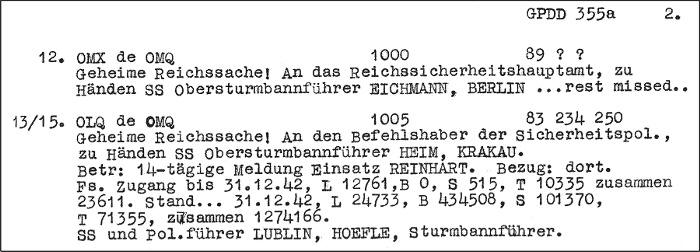Höfle Telegram Public Record Office, Kew, England, HW 16/23, decode GPDD 355a distributed on January 15, 1943, radio telegrams nos 12 and 13/15, transmitted on January 11, 1943.
http://en.wikipedia.org/wiki/H%C3%B6fle_Telegram
The Höfle Telegram[1]
(or Hoefle Telegram) is a document discovered in 2000 among recently
declassified
World War II materials from the
Public Record Office in
Kew, England. The
document consists of two messages, one to
SS
Obersturmbannführer
Adolf Eichmann in
Berlin, and
one to SS Oberststurmbannführer Heim, in
Cracow, sent by SS
Sturmbannführer
Hermann Höfle on January 11 1943. It gave arrivals in the prior
fortnight, and arrivals for the year, for the camps of
Einsatz Reinhardt (later more commonly called
Aktion Reinhard) to December 31, 1942.

Translation
The translation of the decoded message
that British intelligence intercepted.[2]
Note that the interception and decoding was not 100% accurate, as indicated
by "?" and the remarks in square brackets.
12. OMX de OMQ 1000 89 ? ?
State secret! To the Reich Security Main Office, for the attention of SS Obersturmbannführer EICHMANN, BERLIN [gap, rest missed]
13/15. OLQ de OMQ 1005 83 234 250
State secret! To the commander of the Security Police, for the attention of SS Obersturmbannführer HEIM, CRACOW. Re: 14-day report operation REINHARD. Reference: radio telegram from there Recorded arrivals until 31 December 42, L 12761, B 0, S 515, T 10335 totaling 23611. Situation [gap] 31 December 42, L 24733, B 434508, S 101370, T 71355, totaling 1274166. SS and police leader of Lublin, HÖFLE, Sturmbannführer.
For clarity the figures may be arranged as a table:[3]
|
|
Recorded arrivals for the 2
weeks until |
Sum total as of |
|
L (Lublin Majdanek) |
12 761 |
24 733 |
|
B (Belzec) |
0 |
434 508 |
|
S (Sobibor) |
515 |
101 370 |
|
T (Treblinka) |
10 335 |
713 555 |
|
Total |
23 611 |
1 274 166 |
[edit] Importance of the document
According to the US National Security Agency, "It appears the British analysts who had decrypted the message missed the significance of this particular message at the time. No doubt this happened because the message itself contained only the identifying letters for the death camps followed by the numerical totals. The only clue would have been the reference to Operation Reinhard, the meaning of which – the plan to eliminate Polish Jewry that was named after the assassinated SS General Reinhard Heydrich – also probably was unknown at the time to the codebreakers at Bletchley."
This document is only the second to detail the numbers involved in the execution of Einsatz Reinhardt (the other is Korherr’s report, which makes use of the figures in this radio telegram).
Apart from indicating the numbers for 1942, it also indicates that the camp at Lublin (Majdanek), was part of Odilo Globocnik's "Einsatz Reinhardt", a fact that historians previously had not realised.
The discovery of these exact numbers has raised questions as to where the Jews that were admitted to the respective camps came from. At this stage it is still speculative.[3]
[edit] References
-
^ Public Record Office, Kew, England, HW 16/23, decode GPDD 355a distributed on January 15, 1943, radio telegrams nos 12 and 13/15, transmitted on January 11, 1943.
-
^ This is a decoded message, presumably from an Enigma coded message. A missing "5" is added in the table, and is considered to be the correct figure, because (1) The number 713555 yields the correct total of 1274166, and (2) These figures were quoted verbatim in the Korherr Report, with the exception of the "71355", which was given as "713555" by Korherr. The British decoded version would be almost certainly a transcription error. Since British security clearly did not realise what this telegram was about (see above), it is unlikely that the mistake would have been noticed at the time.
-
^ a b Peter Witte and Stephen Tyas, “A New Document on the Deportation and Murder of Jews during ‘Einsatz Reinhardt’ 1942,” Holocaust and Genocide Studies 15:3 (2001) pp. 468-486.